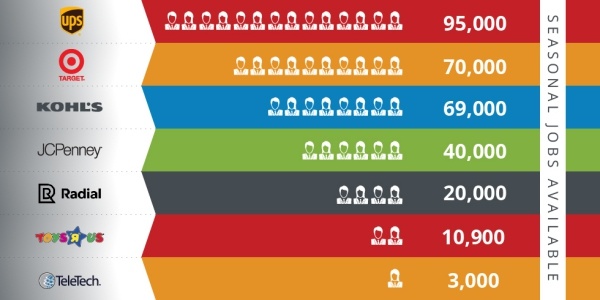Q4 is officially here, which means one thing: retailers, shipment distributors, customer service centers and the rest of the employers who fuel the holiday shopping season are currently engaged in seasonal hiring.
This annual challenge of finding, hiring and training tens of thousands of new employees is, of course, spurred by the holiday shopping season. And, if last year’s retail sales are any indication of the demand businesses will have for part-time, seasonal employees in 2016, we can expect a monster year.
In 2015 alone, U.S. retail sales during the holiday shopping season surpassed the GDP of 181 countries, including Argentina whose yearly GDP is about $538 Billion. And for many employers, given the extreme spikes in customer demand, seasonal hiring is the only way to continue to provide quality customer service and remain competitive during this hectic time of year.
This hiring objective is no doubt daunting and challenging for even a seasoned HR or talent acquisition professional. That said, let’s take a look at the three biggest challenges retailers will face as they ramp up seasonal hiring for the holiday season:
- Big budgets and a lengthy list of vendors cause management nightmares:
When you need to hire 10, 20, 30,000 employees, as many retailers do this time of the year, you’ll have no choice but to advertise your jobs online. Doing so will require you to run multiple pay-per-click (PPC) campaigns across a number of vendors. On each of these vendors, you’ll want to advertise your jobs across a wide array of geo locations and with variations of your job titles so that you’re properly targeting a large enough applicant pool to fulfill your hiring needs. Sound confusing? That’s because it is for most. The best way, then, to handle these multitudes of campaigns and the budgets associated with them is to leverage a recruitment marketing platform that can programmatically pace budget and automate the distribution of jobs to your vendors for you.
- The more hires you need to make, the higher volume of jobs you’ll need to post:
When it comes to attracting a high volume of candidates, the more job advertisements you post, the more applicants you’ll likely receive. If you’re trying to make 500 hires off of one job advertisement, however, you’re going to have a rough go of it. To reach your sky-high seasonal hiring goals, you’ll need a high volume of job advertisements that are specific to the exact skill sets you’re looking for in each new hire. Ideally, you’ll need one open job req per seasonal hire that you want to make. Now, you might think, “How am I supposed to keep thousands of job advertisements organized?” As we mentioned above, the best way to accomplish these goals is by leveraging a recruitment marketing and analytics platform that provides campaign- and job-level data. Doing so will allow you to quickly identify job performance classifications and programmatically adjust your budgets for optimal return.
- Unique hiring periods require a unique PPC strategy:There’s really no other time of the year like the Q4 hiring season for retailers. Unfortunately for the HR and talent acquisition professionals tasked with hiring tens of thousands of new employees, competition is fierce. The vast majority of seasonal jobs are targeted at the same applicant pool, which means clicks and applicants come at a premium, and performance metrics--such as cost-per-click and cost-per-applicant--are inflated. It’s important to understand that cost-efficiency at this time of year isn’t always as important as your applicant and hire volume goals. In fact, trying to keep your cost metrics low could lead to less visibility and an inability to hit your hiring goals. You’ll want to ensure your bids are not only competitive, but that you’re also getting the right media mix (in other words, your job advertisements are diversified across a wide range of vendors to ensure the largest applicant pool for your budget). For instance, since many seasonal hiring roles are for part-time work, you’ll want to ensure your jobs are being advertised on vendors that attract applicants interested in part-time roles. Leveraging a recruitment marketing platform that can allow you to quickly distribute to a number of qualified vendors from a single dashboard will be critical to creating the greatest ROI during this time of year.
According to Google Trends, job seekers in the US begin searching for seasonal work during the first week of September and peak during the first week of November. With peak seasonal candidate traffic fast approaching, you need to ensure you have the right recruitment marketing tools in place to properly execute against your seasonal hiring strategy.
Sign up for a demo today to learn how Recruitics can provide you with powerful recruitment marketing analytics and automation solutions that can help make this hiring season an unprecedented success.



